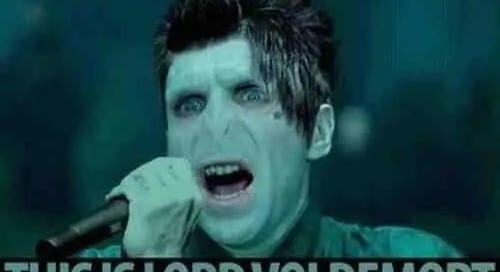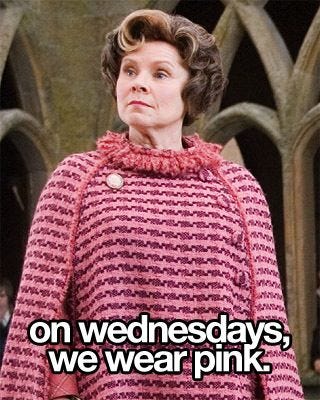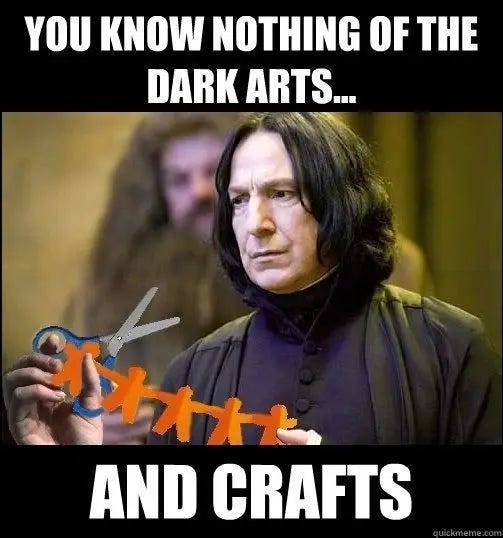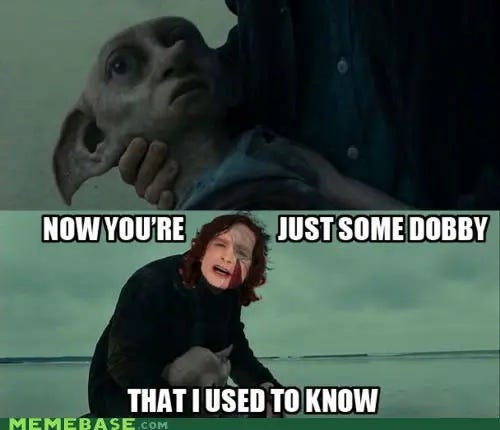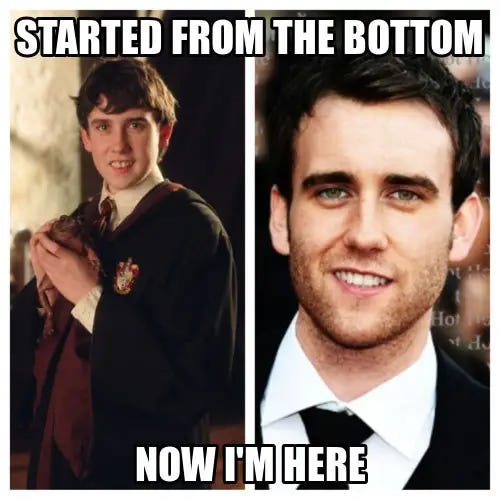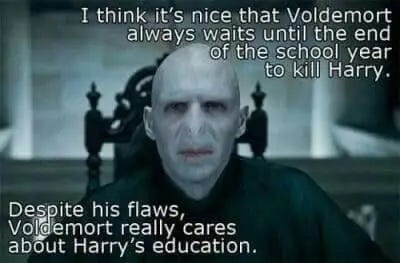Hello Potter My Old Friend (Part 2)
The good, the bad, and the dark magic of watching the Harry Potter films as an adult
“this gives such bittersweet nostalgia. i wish we could live in this era again” -Youtube comment on Harry Potter ambient music"
Unlike The Lord of the Rings, which were shot all at once with a very clear creative vision, the Harry Potter films vary tremendously in quality, tone, and style. They reflect the fact that they were shot over ten years with child actors still learning their craft and had four directors, two screenwriters, two Dumbledores, and a partridge in a pear tree. This inherent chaos and constant change built into their creation makes them equally fascinating and frustrating to watch as an adult. Yes, the casting is generally great, the set and costume design is spot on, and John Williams hits another musical grand slam, but these eight movies also benefitted enormously from a rabid fanbase of the books that was and still is willing to overlook many of their more glaring flaws as films. More clear-eyed viewers will find plenty of screenwriting pitfalls to avoid, bad adaptation choices, and illustrations of when messy magical world building can confuse and even undermine the core story.
Like Taylor Swift, these movies are best conceptualized as a series of eras. The first two films are warm & whimsical children’s movies thanks to the nostalgic direction of Chris Columbus. In film three, Alfonso Cuarón helps the franchise grow up, gaining much visual and thematic nuance and introducing a palpable sense of unease as the menace of adulthood begins to encroach on the child-like wonder of Hogwarts. The Goblet of Fire is the franchise’s messy adolescence, where its identity is most chaotic and it makes some of its weirdest and least flattering choices, thanks to director Mike Newell, who by all accounts didn’t read much less understand the source material. Compared to the iterative riffing of movies one through four, once David Yates takes over in movie five, things become more consistent but also more formulaic. Films five through eight function as a visual and thematic unit, bleeding out all of the warm colors and magical boarding school whimsy as they stomp predictably towards the final showdown. Yates turns these into the kind of drawn out, brooding adolescent drama melded with sprawling CGI set pieces we were seeing in The Hunger Games and Twilight. Speaking of David Yates, let’s pick up where we left off in part 1 with…
The Order of the Phoenix: Rising From The Ashes
Warner Bros / Via memecenter.com
This one was the most fun to watch. Like The Prisoner of Azkaban, it has a clear directorial vision, but what separates it most from The Goblet of Fire is that it a case study in how to adapt a very long book to film: be decisive and ruthless about what book elements have to be there. For example, I didn’t even notice the lack of quidditch in this movie because the quidditch scenes aren’t essential to the story they’re trying to tell.
The key tension of this book is that Harry and Dumbledore know Voldemort has returned but the Ministry of Magic wants to deny this truth. Everything we see from the first frame to the last frame of this movie ties back to this core conflict. This is most apparent in the series best antagonist, Dolores Umbridge, brought to loathsome life by Imelda Staunton. Through some deliberately infuriating scenes and very cleverly edited montages, we see how she makes the school begin to suppress free thought and ban talking openly about dark magic, the wizarding world’s version of banning Critical Race Theory, a plot line that was oddly ahead of its time. Where Goblet of Fire struggled to connect its various dots, The Order of the Phoenix evocatively shows us how much Voldemort’s return is affecting Harry, his friends, the school, and the wizarding world at large, in ways that reinforce rather than distract from each other.
This film breaks important emotional ground by showing Harry struggling with intense pain and alienation after Cedric Diggory’s death. The climaxes of the first three films felt weightless and devoid of consequences as school tended to be magically back to normal again by the next year. Here we finally see Harry dealing with the full psychological weight and complexity of the challenges and tragedy he’s been through.
Rating: 8/10
Dramatic acting legends they got to show up: Imelda Staunton as Dolores Umbridge, Helena Bonham Carter as Bellatrix Lestrange
Who steals the show: Dolores Umbridge
What’s aged the best: The central tension between Voldemort denialism and Dumbledore’s Army, the editing
What’s aged the worst: Harry’s forced, flat, and chemistry-less romance with Cho Chang
Lingering questions: Given that JK Rowling clearly thinks carefully about the meaning of her characters names (Remus Lupin means twin wolf in latin while Dolores and Umbrage mean pain and offense), was Cho Chang really the best she could think of for one of the few Asian characters in the series?
The Half Blood Prince: Snape Kills Dumbledore
Warner Bros / Via groupthink.kinja.com
This first thing you notice is the morose color palette. The latter films get so desaturated that all that’s left is an endless procession of grays, blacks, and blues, like staring at a battleship for well over six gloomy hours.
Speaking of gloomy, this is the movie that made me realize that Ron doesn’t really contribute much to the friend group or plot in the latter parts of the story. While in the first movie he’s winning key chess matches, by movie six he’s just there as a ball of teenage hormones while Hermione continues being smart and Harry gets to be heroic. If he’s intended to be Harry’s loyal best friend then why do they spend so much time showing him be so insufferable?
This film also made it apparent that a clear downside of having a large and growing cast like this is how beloved characters get sidelined by later films because there’s just not enough screen time to go around. Here they introduce yet another quirky professor plus a forgettable suitor for Hermione, leaving beloved MacGonagal with only four lines of dialogue, half of which are some version of "Go back to your dormitories!”
The best moments in this one are when they’re advancing Dumbledore and Harry’s quest to learn more about Voldemort’s past so they can defeat him. The worst moments are the teenage romance subplots, which make the second half drag. A wiser adaptation would have found ways to connect these blossoming romances to the arc of evil gradually eclipsing good at Hogwarts & beyond. Make us feel that Harry and Ginny coming together is a tender and touching reaction to how dark and uncertain life is becoming for these young adults, that their blossoming love is a flickering candle whose warmth and light are increasingly necessary to survive. Instead, this movie relies on telling us that Harry is close to two Weasleys while showing us that he has chemistry with neither of them.
Rating: 7/10
Dramatic acting legends they got to show up: Jim Broadbent as Horace Slughorn
Who steals the show: Dumbledore
What’s aged the best: The Snape, Dumbledore, Draco, and Harry arc, the Quidditch CGI, which is noticeably better in this one
What’s aged the worst: Harry’s forced, flat, and chemistry-less romance with Ginny Weasley
Lingering questions: Why is Ginny’s characterization so inconsistent film to film? Is the fact that the teen romances flounder JK Rowling’s fault or the filmmakers? Whose decision was it to make Harry on the Felix Felicis potion sound like he’s rolling on MDMA?
The Deathly Hallows Pt. 1: The World’s Gloomiest Camping Trip
Warner Bros / Via Memebase.com
This gets off to a promising start and then self destructs. The first act is a gripping heist movie, with a thrillingly destructive car chase that could belong in any other blockbuster were it not for the polyjuice potion that had been quaffed just beforehand. Then it screeches to a halt and becomes a grim, lonely, and never-ending camping trip that makes even the bleakest moments of The Return of The King look like Burning Man in comparison. So much of the screen time is just camping scenes in various rugged locations, whose geographic relation to each other is confusingly vague, the main trio waiting around and bickering until Hermione has an epiphany. The result is major pacing issues and a stagnant, hopeless tone that make this a joyless chore to watch. Worse, Ron is yet again insufferable and Harry and Hermione continue to display more chemistry than Ron and Hermione, making Ginny and Ron’s romantic arcs feel un-earned.
Rating out of 10: 4/10
Dramatic acting legends they got to show up: This film introduces no new important actors in the same way that this movie introduces precious little to the franchise
Who steals the show: No one
What’s aged the best: The tale of the 3 brothers, which feels out of a different, better Harry Potter movie
What’s aged the worst: The never-ending Horcrux scavenger hunt scenes
Lingering questions: Why did they kill Mad Eye Moody offscreen? Why do they sometimes have to say silly words to cast a spell but other times can just point their wands and fire one off? Can anyone convincingly explain to me why didn’t Harry and Hermione end up together?
The Deathly Hallows Pt. 2: Oops, All Climax
Warner Bros/ Via memecrunch.com
This one starts off worryingly similar to the last one, refusing to have any fun even when given the chance. Before we get find another Horcrux, we have wade through even more logistics and lore. Then, when we head to Gringott's for a bank heist, which could have been edited in a snappy, exciting fashion, but is instead oddly slow and plodding. I would have objected to Harry using an unforgivable curse, an innocent goblin getting incinerated, and yet again over-relying on Polyjuice potion to advance the plot if I wasn’t so desperate for this sequence to end so I could see unfiltered sunlight and have fun again.
My prayers were answered when our trio finally returns to Hogwarts. When MacGonagal ousts Snape and begins preparing Hogwarts’s defenses for the final battle, Alexis sat up and exclaimed, “finally, we’re having fun again!”
The battle of Hogwarts is what you came for, pitting Harry and his loyal friends and professors against a huge army of death eaters, who look like a bunch of bikers mixed with soccer hooligans. I enjoyed the ensuring melee even though I still don’t understand why Harry & friends won’t use killing curses when their opponents have no such qualms. Few resistance movements in real life have defeated fascist racial purity movements with stun charms and stunningly hot Nevilles alone, but I digress.
My only major qualm with this one were how the plot feels very climactic but the character arcs do not. Only Snape’s emotional arc feels fulfilling. Yes, Harry makes peace with death in a fairly touching way, but the mechanics of this essentially boil down to a saying “I am rubber, you are glue” to Voldemort. Ron and Hermione undergo no change whatsoever other than deciding that they’ll finally have to have that kiss they’ve been putting off because they have less chemistry than Mike Pence and AOC forced to share an Uber. You can tell director David Yates was unsure of how to land the plane after so much wand whooshing because the last thing we see of our actors before the saccharine epilogue is them awkwardly holding hands while staring off of a bridge in silence.
Amidst a chaotic maelstrom of CGI spells, gigantic trolls, and chunks of Hogwarts masonry flying everywhere, this film manages to deliver some surprisingly touching emotional payoffs in its quieter moments. The concluding scene of Snape’s eight movie long arc is fittingly emotional and nuanced. Harry’s brief layover in the afterlife is poignant, despite Dumbledore’s tendency to vomit exposition like he’s suffering from food poisoning after eating all of the books. All in all, this movie offers more fan service than an HVAC repair company.
Rating out of 10: 8/10
Dramatic acting legends they got to show up: Neville Longbottom’s glow up
Who steals the show: Neville Longbottom
What’s aged the best: Neville Longbottom, Snape’s redemption arc.
What’s aged the worst: The epilogue scene at the end, fairly literally
Lingering questions: What is Neville Longbottom’s skincare and workout regimen like? Was MacGonagal imprisoning all of the Slytherins before the final battle just saying the quiet part out loud? I am once again asking: can anyone convincingly explain why Harry and Hermione didn’t end up together?
Concluding Thoughts
Warner Bros / Via funnybits.mobi
My viewing experience convinced me of exactly three things.
John Williams is a genius.
JK Rowling writes captivating but messy stories that, like her political views, should never be examined under a microscope or black light, lest they turn to frustrating, nonsensical mush.
Chasing childhood nostalgia is a curious exercise.
This last one hit the hardest. So much of the magic of the books that enthralled me as a child is so hard to remember much less relive now. Like Harry, there’s no going back to who I was when I started this journey. While I can never recapture the wonder of the eight year old I was when I first encountered this magical story, I certainly understand why so many feel compelled to try. I really miss the little boy that didn’t have so many reasons to be cynical about the world, hadn’t yet been repeatedly disappointed by everything fun getting gobbled up and shat out as a bloated cinematic franchise, and who could focus and suspend disbelief long enough to fully lose himself in fiction regularly. There was a time pre-taxes and push notifications when powering through a doorstop of a children’s book was all I needed to worry about in my summer days. Those were magical times, but I have to face the fact that no Hollywood spell can conjure them up again. Is it sadder to admit this or deny it? I’m honestly not sure. Do I still miss my lost innocence regardless? Always.
Did you enjoy the Harry Potter books? The movies? Which ones were your favorites and least favorites?
Do you know someone that would enjoy this article? Share it with them!
If you enjoyed reading this and want to support more content like this please, consider becoming a subscriber. A free or paid subscription is a great way to support my writing and make sure you never miss a post.
